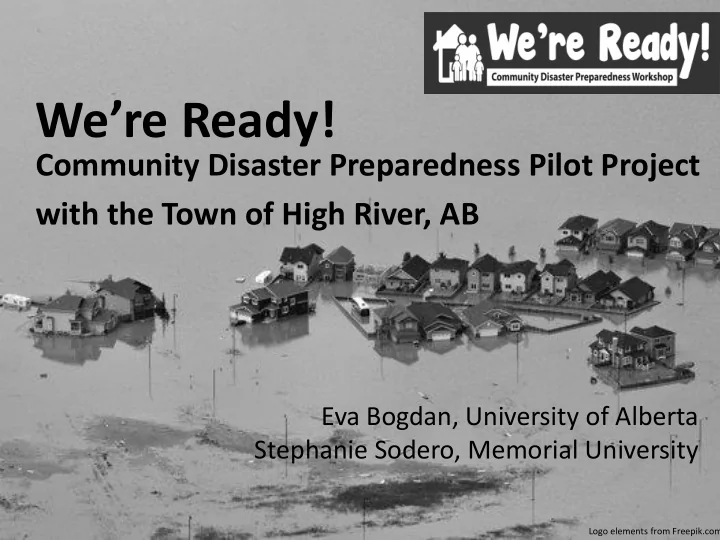

We’re Ready! Community Disaster Preparedness Pilot Project with the Town of High River, AB Eva Bogdan, University of Alberta Stephanie Sodero, Memorial University Logo elements from Freepik.com
Context • 85% of Canadians agree that disaster preparation is important • ~ 40% of Canadians have undertaken preparation • Pressure on limited municipal emergency response resources (Alberta Disaster Management Agency, nd; Juliet and Koji, 2013)
Context • Communities with strong social ties are more resilient (Aldrich, 2015) • Disaster preparedness and response programs are more successful when they are community-driven (Grogg, 2015) • Relationships are the most important levers of emergency preparedness (Donahue & Tuohy, 2006) • Neighbourhood-based approach to disasters; low casualty rates during disasters – E.g. Netherlands, Cuba, Chile
Gap • Gap in scholarly and practitioner knowledge on community-level disaster preparedness and response – E.g. Immigrant populations were largely ignored in disaster strategic plans enacted during Hurricane Katrina (Cherry and Allred, 2012) • Culturally appropriate disaster preparedness programs need to be developed and tested (Eisenman et al., 2009) • Low uptake of disaster preparedness at community and individual/household level in High River (Bogdan, n.d.)
We’re Ready • High River, May 2016 • Pilot Project developed and implemented to address gap in emergency preparation and response at the community-level – Ethnic: Filipino – Geographical: SW/all of High River
Purpose • Facilitate target communities in designing and implementing their own disaster preparedness program through fun and engaging community-building activities.
Goals • Reduce confusion and distress • Prevent injury/save lives • Minimize/avoid damages • Intended to complement existing emergency plans
Deliverables • Hazard and evacuation maps • Communication plans • Community capacity inventory
What’s New( ish)? • Community-based (not household) • Building of social networks/capital • Participants design their own plans • Based on principles of program planning & adult education • Community partners contributed to development and implementation of project • Facilitated (not led) • Compare results from two different communities (ethnic and geographic) • Interactive and fun activities
High River 2013
Partners Team: • Committee met every • Academics • Community practitioners few weeks Jan. to May (Town of High River) in person or via phone • Community volunteers – Representatives G.
Workshops • Two one-day workshops (~$2,000) – Saturday: 23 Filipino community members – Sunday: 11 General public members • Pre- and post-workshop surveys based on Statistics Canada’s 2014 Survey of Emergency Preparedness and Resilience in Canada (SEPR)
Activities Welcome 5. Community plan 1. Pre-workshop survey 6. Offsite mock disaster game 2. Community bingo 7. Debrief exercise 3. Share experiences 8. Our team 4. Mapping 9. Post-workshop evaluation
Activity 2: Community bingo • Goals: Identify community members in terms of their name, skills, needs, resources etc. • Tool: ERP bingo sheet and prizes
Activity 4: Evacuation and meeting • Goal: Encourage group to identify primary and alternate evacuations routes and muster points • Tool: Group mapping exercise
Activity 8: Mock disaster game • Goals: Gain practical experience of disaster and operationalization of response • Tool: Mock tornado response activity – physical victims – emotional victims – responders
What worked well? • Great Organizing Team “It’s better to be together, • Well prepared and than alone!” organized “[Want] more training to help • Activities rated high in the community in times of disaster.” • Workshops rated high • Build on existing social ties • Demand for more • Community team leads emerged to continue working on emergency plans
What could have worked better? Saturday – Filipino community • Unexpected double night shift for workers lower attendance • Survey too long with translation Sunday – General community • Church community lower attendance • Group did not “gel” b/c most of them did not have existing social ties
Transferability / All-hazards approach
Next Steps • We’re Ready! Website – Description of the program – Free resources to replicate the workshop at other locations • Future workshops: • High River: Latino community? Seniors? • Airdrie • Edmonton
Contact Eva Bogdan University of Alberta ebogdan@ualberta.com evabogdan.com More information on the Carly Benson We’re Ready! Program Director of Emergency Management, available at: Town of High River info@highriver.ca http://www.wereready.org/ Stephanie Sodero Memorial University stephaniesodero.weebly.com/ Logo elements from Freepik.com
References Alberta Emergency Management Agency. No date. Facts about emergency preparedness. Aldrich, D. 2015. December 9. Some communities are destroyed by tragedy and disaster. Others spring back. Here’s what makes the difference. The Washington Post . Cherry, S. M. and Allred, K. 2012. Models of disaster response: lessons learned from Filipino immigrant mobilizations for Hurricane Katrina evacuees. Criminal Justice Studies 25 (4):391-408. Donahue, A. K. & Tuohy, R. V. (2006, July). Lessons we don't learn: A study of the lessons of disasters, why we repeat them and how we can learn them. Monterey, California: Naval Postgraduate School, Center for Homeland Defense and Security. Retrieved from http://hdl.handle.net/10945/25094. Eisenman, D. P., Glik, D., Maranon, R., Gonzales, L., and Asch, S. 2009. Developing a disaster preparedness campaign targeting low-income Latino immigrants: focus group results for project PREP. Journal of health care for the poor and underserved , 20 (2), 330-345. Grogg , P. 2015, July 17. Community drills part of Cuba’s top -notch disaster response system. Inter Press Service News Agency . Juillet, L. and Koji, J. 2013. Policy change and constitutional order: Municipalities, intergovernmental relations, and the recent evolution of Canadian emergency management policy. In D. Henstra (Ed.), Multilevel governance and emergency management in Canadian municipalities (Vol. 6) (pp. 25 – 61). Montreal, Quebec: McGill- Queen’s University Press.
Funding acknowledgement Funding for We’re Ready! Project provided by the Centre for Community Disaster Research (CCDR) at Mount Royal University. The need for such a pilot project arose from literature review on disasters and findings from Eva Bogdan’s PhD research on flood management in High River and Stephanie Sodero’s PhD research on hurricanes in eastern Canada. Both researchers are funded by the Social Science and Humanities Research Council (SSHRC).
Recommend
More recommend